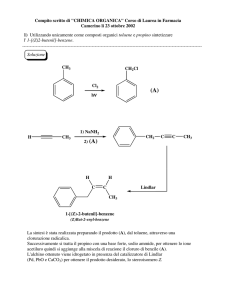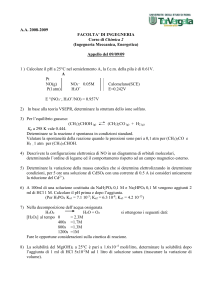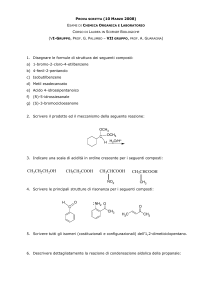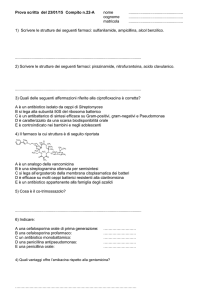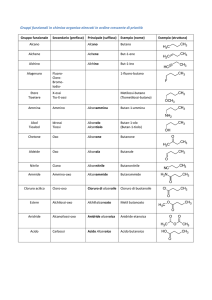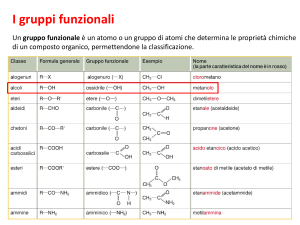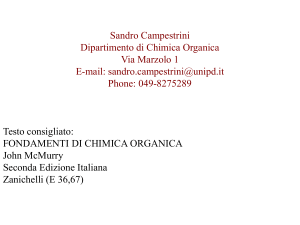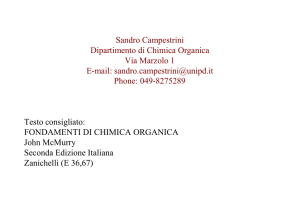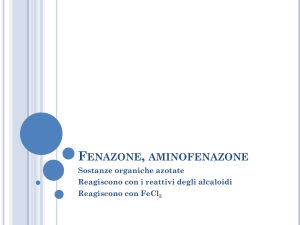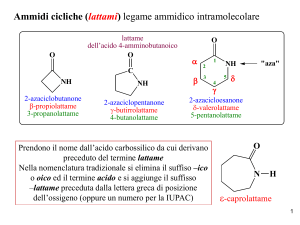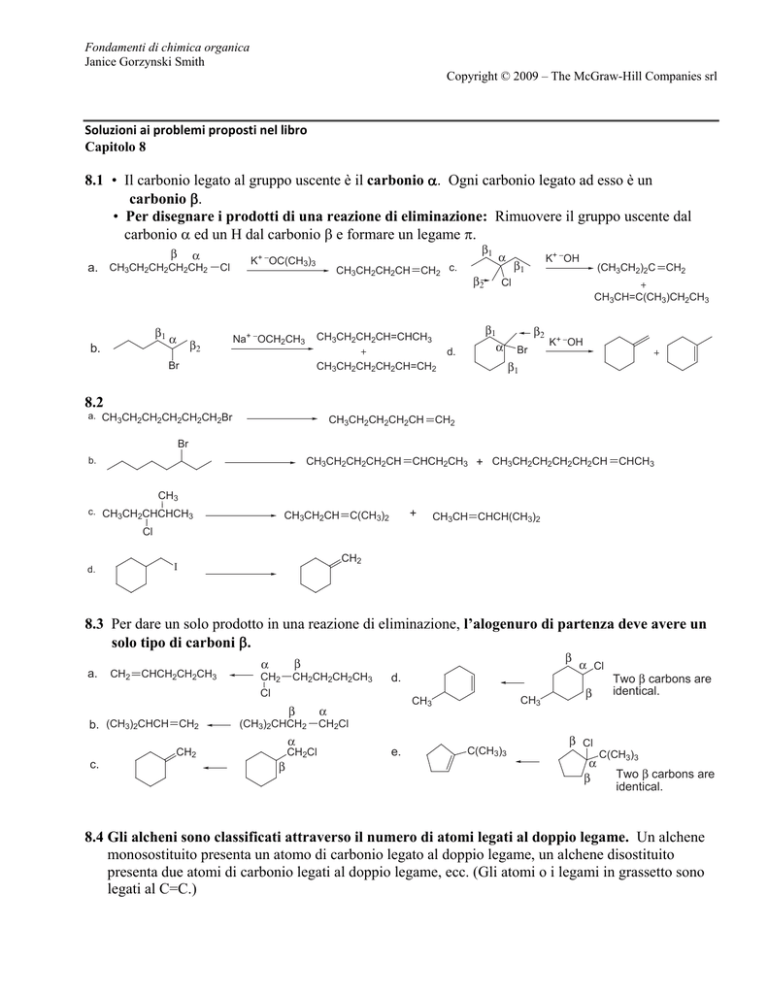
Fondamenti di chimica organica
Janice Gorzynski Smith
Copyright © 2009 – The McGraw-Hill Companies srl
Soluzioni ai problemi proposti nel libro Capitolo 8
8.1 • Il carbonio legato al gruppo uscente è il carbonio α. Ogni carbonio legato ad esso è un
carbonio β.
• Per disegnare i prodotti di una reazione di eliminazione: Rimuovere il gruppo uscente dal
carbonio α ed un H dal carbonio β e formare un legame π.
β
α
a. CH3CH2CH2CH2CH2
Cl
β1
K+ −OC(CH3)3
CH3CH2CH2CH CH2 c.
β2
α
K+ −OH
β1
(CH3CH2)2C CH2
Cl
CH3CH=C(CH3)CH2CH3
β1
b.
α
β2
Na+ −OCH2CH3
CH3CH2CH2CH=CHCH3
d.
Br
β1
α
β2
Br
K+ −OH
β1
CH3CH2CH2CH2CH=CH2
8.2
a. CH3CH2CH2CH2CH2CH2Br
CH3CH2CH2CH2CH
CH2
Br
b.
CH3CH2CH2CH2CH
CHCH2CH3 + CH3CH2CH2CH2CH2CH
CHCH3
CH3
c. CH3CH2CHCHCH3
+
CH3CH2CH C(CH3)2
CH3CH CHCH(CH3)2
Cl
CH2
I
d.
8.3 Per dare un solo prodotto in una reazione di eliminazione, l’alogenuro di partenza deve avere un
solo tipo di carboni β.
a.
CH2
CHCH2CH2CH3
β
β
α
CH2
CH2CH2CH2CH3
Cl
β
b. (CH3)2CHCH CH2
(CH3)2CHCH2
α
CH2
c.
CH2Cl
β
α Cl
d.
CH3
CH3
α
β
Two β carbons are
identical.
CH2Cl
e.
C(CH3)3
β Cl
α
β
C(CH3)3
Two β carbons are
identical.
8.4 Gli alcheni sono classificati attraverso il numero di atomi legati al doppio legame. Un alchene
monosostituito presenta un atomo di carbonio legato al doppio legame, un alchene disostituito
presenta due atomi di carbonio legati al doppio legame, ecc. (Gli atomi o i legami in grassetto sono
legati al C=C.)
Fondamenti di chimica organica
Janice Gorzynski Smith
Copyright © 2009 – The McGraw-Hill Companies srl
CH3
a. CH3CH
CHCH2CH3
b.
d.
c.
CH2
CH3
4 C's bonded to C=C
tetrasubstituted
3 C's bonded to C=C
trisubstituted
2 C's bonded to C=C
disubstituted
2 C's bonded to C=C
disubstituted
8.5 Perchè esistano isomeri cis e trans, i due gruppi su ciascun carbonio terminale del doppio legame
devono essere diversi tra loro.
2 different groups
(CH3CH2 and H)
a.
c. CH2 CHCH2CH2CH3
b. CH3CH2CH CHCH3
two CH3 groups
no cis or
trans isomers
2 different groups 2 different groups
(cyclohexyl and H) (cyclohexyl and H)
2 different groups
(H and CH3)
cis and trans isomers possible
d.
CH CH
cis and trans isomers possible
two H's
no cis or
trans isomers
8.6 Due definizioni:
• Gli isomeri costituzionali differiscono nell’ordine in cui gli atomi sono legati fra loro.
• Gli stereoisomeri differiscono solo nella disposizione 3-D degli atomi nello spazio.
a.
c.
and
C C
H
and
trans
d.
trans
identical
H
C C
and
H
H
CH3
cis
trans
different arrangement of atoms in space
stereoisomers
different connectivity of atoms
constitutional isomers
b.
CH3CH2
CH3
CH3CH2
CH3CH2
H
C C
CH3
CH3CH2
and
H
CH3
C C
H
H
different connectivity of atoms
constitutional isomers
8.7 Due regole per predire la stabilità relativa degli alcheni:
[1] Gli alcheni trans sono più stabili di quelli cis.
[2] La stabilità di un alchene aumenta all’aumentare dei gruppi R sul doppio legame C=C.
Fondamenti di chimica organica
Janice Gorzynski Smith
Copyright © 2009 – The McGraw-Hill Companies srl
a.
and
monosubstituted
b.
C C
trans
more stable
cis
8.8
CH2CH3
H
H
H
disubstituted
trisubstituted
more stable
C C
and
CH3
and
c.
H
CH3CH2
CH2CH3
CH3CH2
CH3
disubstituted
more stable
Usare le definizioni della risposta 8.6.
CH3
a.
CH2
and
and
c.
trans trans
different connectivity
constitutional isomers
trans trans
identical
H
CH3CH2
CH3
CH3CH2
CH3
CH3
CH2CH3
C
C C
and
C C
b.
CH2CH3
CH3
CH3
d.
CH3
C
and
CH3
stereoisomers
H
CH3
stereoisomers
8.9 Ci sono tre isomeri diversi. Gli isomeri cis e trans sono diastereomeri.
H
Cl
H
C C
H
Br
H
C C
Br
A
constitutional isomer
of B and C
Cl
H
C C
H
B
Cl
C
Br
diastereomers
8.10
Double bond can be cis or trans.
OH
PGF2α
HO
CH2CH CH(CH2)3COOH
CH CHCH(OH)(CH2)4CH3
a. 5 sp3 stereogenic centers (4 circled, one labeled)
b. 2 double bonds can both be cis or trans.
c. 27 = 128 stereoisomers possible
sp3 stereogenic center
Double bond can be cis or trans.
8.11 Usare le regole delle risposta 8.5 per ordinare gli alcheni.
Fondamenti di chimica organica
Janice Gorzynski Smith
Copyright © 2009 – The McGraw-Hill Companies srl
CH3CH2
CH3 CH3CH2
H
monosubstituted
H
H
disubstituted
cis
intermediate
stability
least stable
H
C C
C C
a. CH2 CHCH2CH2CH3
b.
CH3
disubstituted
trans
most stable
CH2
CHCH(CH3)2
monosubstituted
least stable
CH2
C(CH3)CH2CH3
disubstituted
intermediate
stability
(CH3)2C CHCH3
trisubstituted
most stable
8.12 Un valore più negativo di ∆H° significa che la reazione è più esotermica. Poichè sia l’1butene che il cis-2-butene formano lo stesso prodotto (butano) questo dato mostra che l’ 1-butene
presenta un’energia più elevata, dal momento che viene rilasciata più energia nella reazione di
idrogenazione.
+ H2
CHCH2CH3
1-butene
+ H2
C C
H
cis-2-butene
= −30.3 kcal/mol
CH3
CH3
1-butene
CH3CH2CH2CH3
ΔHo
CH3CH2CH2CH3
larger ² H° for
1-butene
higher in energy
energy
CH2
ΔHo = −28.6kcal/mol
H
butane
cis-2-butene
smaller ² H° for
cis-2-butene
lower in energy
more stable
8.13 In un meccanismo E2, quattro legami sono coinvolti in un singolo passaggio. Usare le frecce curve
per mostrare queste azioni simultanee:
[1] La base attacca un idrogeno su un carbonio β.
[2] Si forma un legame π.
[3] Il gruppo uscente viene allontanato.
CH3CH2
CH3CH2
β carbon
C CHCH3
(CH3CH2)2C=CHCH3
Br H
+
HOCH2CH3
+
Br
new π bond
OCH2CH3
transition state:
CH3CH2
CH3CH2
C
−
CHCH3
δ Br H
OCH2CH3
δ−
8.14 Perchè possa avvenire una eliminazione E2 è necessaria la presenza di almeno un idrogeno su un
carbonio β.
Fondamenti di chimica organica
Janice Gorzynski Smith
Copyright © 2009 – The McGraw-Hill Companies srl
β carbon
CH3 H
CH3
C H
C
no H's on β carbon
inert to E2 elimination
CH3 Br
8.15
better leaving group
faster reaction
a. CH3CH2 Br
+
OH
CH3CH2
+
OC(CH3)3
Br
b. CH3CH2 Br
+
OC(CH3)3
CH3CH2
+
OC(CH3)3
Cl
stronger base
faster reaction
8.16 All’aumentare dei gruppi R sul carbonio che porta il gruppo uscente, la velocità di una reazione E2
aumenta.
a. (CH3)2CHCH2CH2CH2Br
(CH3)2CHCH2CH(Br)CH3
2° alkyl halide
intermediate reactivity
1° alkyl halide
least reactive
3° alkyl halide
most reactive
CH3
Cl
Cl
b.
Cl
1° alkyl halide
least reactive
(CH3)2C(Br)CH2CH2CH3
CH3
2° alkyl halide
intermediate reactivity
3° alkyl halide
most reactive
8.17 Usare le seguenti caratteristiche di una reazione E2 per rispondere alle domande:
[1] Le reazioni E2 sono del secondo ordine ed ad un singolo stadio.
[2] Gli alogenuri più sostituiti reagiscono più velocemente.
[3] Le reazioni con basi forti o gruppi uscenti migliori sono più veloci.
[4] Le reazioni con solventi polari aprotici sono più veloci.
Equazione della velocità: velocità = k[RX][Base]
a. triplicare la concentrazione dell’alogenuro alchilico = la velocità triplica
b. dimezzare la concentrazione della base = la velocità dimezza
c. cambiare il solvente da CH3OH a DMSO = la velocità aumenta (Un solvente polare aprotico è
migliore per l’E2.)
d. cambiare il gruppo uscente da I− a Br− = la velocità decresce (I− è un gruppo uscente migliore.)
e. cambiare la base da −OH a H2O = la velocità decresce (base più debole)
f. cambiare l’alogenuro alchilico da CH3CH2Br a (CH3)2CHBr = la velocità aumenta (Gli
alogenuri più sostituiti reagiscono più velocemente).
8.18 La regola di Zaitsev stabilisce: In una reazione di β-eliminazione, il prodotto maggioritario ha il doppio
legame più sostituito.
Fondamenti di chimica organica
Janice Gorzynski Smith
Copyright © 2009 – The McGraw-Hill Companies srl
CH3 H
a.
CH3
C
C
H
α
CH2CH3
Br
loss of H and Br
CH3
b.
α
Br
(CH3)2C CHCH2CH3 +
trisubstituted
major product
(CH3)2CHCH CHCH3
disubstituted
minor product
CH3
CH3
CH2
CH3
CH3
CH3
loss of H and Br
CH3
trisubstituted
minor product
tetrasubstituted
major product
disubstituted
minor product
Cl
α
c.
monosubstituted
minor product
CH3
CH3
α Cl
d.
CH3
CH3
CH3CH2CH2CH2CH=CHCH3
loss of H and Cl
trisubstituted
loss of H and Cl
CH3 ONLY product
CH3
disubstituted
major product
Fondamenti di chimica organica
Janice Gorzynski Smith
Copyright © 2009 – The McGraw-Hill Companies srl
8.19
Cl
a.
β1
α
(CH3)3CO
CH3CH=CHCH2CH2CH(CH3)2
β2
(loss of β2 H)
major product
disubstituted
(loss of β1 H)
monosubstituted
DBU
b.
O
only product
O
O
β3
CH3
I
β1
c.
β α
O
Cl
α
OH
CH3CH2C(CH3)=C(CH3)CH2CH2CH3
β2
β
α
OC(CH3)3
CHCH2CH3
(loss of β2 H)
(loss of β1 H)
major product
tetrasubstituted
Cl
d.
CH3CH2CH(CH3)C(CH3)
trisubstituted
CH2
(loss of β3 H)
only product
disubstituted
β2
e.
β1
β2
f.
α
Br
OH
α I
CH3CH2CH2CH2CH=CHCH3
(loss of β1 H)
major product
disubstituted
(loss of β2 H)
monosubstituted
OH
β1
(loss of β2 H)
major product
trisubstituted
(loss of β1 H)
disubstituted
8.20 Per dare un alchene solo come prodotto dell’eliminazione, l’alogenuro alchilico deve avere
alternativamente:
• Solo un carbonio β con un atomo di idrogeno.
• Tutti i carboni β identici così che i prodotti dell’eliminazione risultano identici.
CH3 H
CH3
only one
β carbon
C
C H
H
Cl
CH3
C
CH3
H
β
CH3
C
H
β
CH3 H
C
C H
Cl
H
β
β Carbons are identical.
Fondamenti di chimica organica
Janice Gorzynski Smith
Copyright © 2009 – The McGraw-Hill Companies srl
8.21 Disegnare i prodotti della reazione E2 e confrontare il numero dei carboni legati al C=C.
β1
A
β2
β2
α
β1 α
major product
trisubstituted
Br
Br
β1
(CH3)2CHCH=CHCH3
α
disubstituted
α
α
α
(CH3)2CHCH=CHCH3
β2
β1
major product
disubstituted
B
β2
monosubstituted
A fornisce un alchene trisostituito come prodotto maggioritario ed un alchene disostituito come prodotto
secondario. B fornisce un alchene disostituito come prodotto maggioritario ed un alchene
monosostituito come prodotto secondario. Poiché sia il prodotto maggioritario che quello secondario
formati da A hanno più gruppi alchilici (e sono quindi più stabili) di quelli formati da B, A reagisce più
velocemente in una reazione di eliminazione.
8.22
a. Mechanism:
By-products
−
OC(CH3)3
Br
+ HOC(CH3)3 + Br−
(CH3)3COH
H
b.Rate = k[R-Br][−OC(CH3)3]
1. Solvent changed to DMF (polar aprotic) = rate increases
2. [−OC(CH3)3] decreased = rate decreases
3. Base changed to −OH = rate decreases (weaker base)
4. Halide changed to 2° = rate increases (More substituted RX reacts faster.)
5. Leaving group changed to I— = rate increases (better leaving group)
8.23
+
With a less sterically hindered base, more of
the more stable product is formed.
Br
CH3CH2O–
(CH3)3
21%
73%
CO–
79%
27%
As the base gets bigger, the more
accessible proton is removed more easily.
Removal of the less accessible 2o H gives the more substituted, more stable alkene.
2° H
H H
CH3
C
C
CH3
CH3 Br
loss of 2o H
This pathway is usually favored, as is
the case with CH3CH2O– as base.
more stable alkene
Fondamenti di chimica organica
Janice Gorzynski Smith
Copyright © 2009 – The McGraw-Hill Companies srl
Removal of the more accessible 1o H gives the less substituted, less stable alkene.
CH3
CH2
CH3
C
CH2 Br
loss of 1o H
H
1° H
As the base gets bulkier, the
more accessible proton is
removed faster; thus, the 1° H
reacts faster than the 2° H, and
the less stable alkene predominates.
less stable alkene
1o
The
H is more accessible,
less sterically hindered.
With a bulkier base,
this proton is more readily removed.
Explanation: 1° H's are more easily removed than 2° H's with sterically hindered bases.
8.24
H
a. CH3CH2CH2
KOH
C
trans isomer more stable
major product
Br
b.
NaOCH2CH3
trans isomer more stable
major product
Cl
8.25 Un meccanismo E1 presenta due stadi:
[1] Il gruppo uscente si distacca, originando un carbocatione.
[2] Una base estrae un protone da un carbonio β, e si forma un legame π.
CH3
CH3
C
CH2CH3
[1]
+ CH3OH
CH3
CH3
[2]
+
(CH3)2C=CHCH3 + CH3OH2 + Cl
H
Cl
transition state [1]:
C CH CH3 CH3OH + Cl
CH3
CH3 +C CH2 CH3
δ
Cl
δ−
transition state [2]:
CH3
CH3
C
δ+
CH CH3
H
OCH3
δ+
H
8.26 La regola di Zaitsev stabilisce: In una reazione di β-eliminazione, il prodotto maggioritario ha il doppio
legame più sostituito.
Fondamenti di chimica organica
Janice Gorzynski Smith
Copyright © 2009 – The McGraw-Hill Companies srl
β2
CH3CH2
a.
CH3
CH3
β1
α
C CHCH3
CH3CH2
C CH2CH3 + H2O
Cl
CH3CH2
β1
+
C CH2
CH3CH2
trisubstituted
major product
β1
CH2CH2CH3
β3
8.27
CH2CH2CH3
CH3
α
b.
I
β2
disubstituted
+
CH3
CH3OH
CH2CH2CH3
CH2
+
CH2CH2CH3
CH3
+
trisubstituted
disubstituted
tetrasubstituted
major product
Usare le seguenti caratteristiche di una reazione E1 per rispondere alle domande:
[1] Le razioni E1 sono del primo ordine ed a due stadi.
[2] Alogenuri più sostituiti reagiscono più velocemente.
[3] Sono preferite basi più deboli.
[4] Le reazioni con migliori gruppi uscenti sono più veloci.
[5] Le reazioni in solventi polari protici sono più veloci.
Equazione della velocità: velocità = k[RX] La base non influenza la velocità.
a. Raddoppio della concentrazione dell’alogenuro alchilico = la velocità raddoppia
b. Raddoppio della concentrazione della = nessun cambiamento (La base non è presente
nell’equazione della velocità.)
c. cambiare l’alogenuro alchilico da (CH3)3CBr a CH3CH2CH2Br = la velocità decresce
(Alogenuri più sostituiti reagiscono più velocemente.)
8.28 Sia la reazione SN1 che quella E1 procedono attraverso la formazione di un carbocatione. Per
disegnare i prodotti:
[1] Per la reazione SN1, sostituire il nucleofilo al gruppo uscente.
[2] Per la reazione E1, rimuovere un protone da un carbonio β e creare un nuovo legame π.
CH3
CH3
Br
a.
+ H 2O
leaving
group nucleophile
and base
SN1 product
CH3
Cl
nucleophile
and base
CH3
CH3
E1 products
CH3
b. CH3 C CH2CH2CH3 + CH3CH2OH
leaving
group
CH2
OH
C CH2CH2CH3
OCH2CH3
SN1 product
CH3
CH3
C CH2
CH3CH2CH2
C CHCH2CH3
CH3
E1 products
Fondamenti di chimica organica
Janice Gorzynski Smith
Copyright © 2009 – The McGraw-Hill Companies srl
8.29 Le reazioni E2 sono favorite da basi con una forte carica negativa ed avvengono con alogenuri
1°, 2° e 3°, essendo i 3° i più reattivi.
Le reazioni E1 sono favorite da basi neutre più deboli e non avvengono con alogenuri 1° poiché
essi formano carbocationi molto instabili.
C(CH3)3
CH3
a.
CH3
C CH3
Cl
+
Cl
c.
OCH3
+
strong negatively
charged base
E2
I
b.
+
CH3OH
weak neutral
base
E1
H2O
d. CH3CH2Br
weak neutral
base
E1
+
OC(CH3)3
strong negatively
charged base
E2
8.30
CH3
a.
CH3
CH3
CH2
Cl
CH3
CH3
tetrasubstituted
major product
CH3
CH3
trisubstituted
disubstituted
Br
b.
trisubstituted
This isomer is more stable large groups further away.
major product
c.
trisubstituted
Cl
disubstituted
8.31
disubstituted
Usare le regole della risposta 8.29.
trisubstituted
major product
Fondamenti di chimica organica
Janice Gorzynski Smith
Copyright © 2009 – The McGraw-Hill Companies srl
a.
OCH3
CH3CH CHCH3
strong base
E2
Br
2° halide
CH3OH
b.
Br
(cis and trans)
strong base
E2
1° halide
H2O
CH2CH2CH3
CHCH2CH3
Cl
CH3
CH3CH2CH CH2
OC(CH3)3
I
c.
d.
CH3CH CHCH3
weak base
E1
2° halide
CH3CH2CH CH2
(cis and trans)
weak base
3° halide
E1
CH2CH2CH3
CH3
CH3
OH
Cl
e.
strong base
E2
2° halide
OH
f.
2° halide
strong base
E2
Cl
8.32 L’ordine di reattività è lo stesso sia per E2 che E1: 1° < 2° < 3°
a.
Br
Br
Br
1° halide
2° halide
3° halide
increasing reactivity in E1 and E2
CH3
b.
Cl
2° halide
Br
CH3
CH3
Cl
3° halide
3° halide +
better leaving group
increasing reactivity in E1 and E2
8.33
CH2CH2CH3
CH3
Fondamenti di chimica organica
Janice Gorzynski Smith
Copyright © 2009 – The McGraw-Hill Companies srl
CH3
a.
Cl
Cl
OH
H2O
b.
CH3 Cl
3° halide - faster reaction
CH3
OH
c. (CH3)3CCl
H2 O
strong base - E2
H2O
OH
(CH3)3CCl
Cl
DMSO
OH
3° halide - faster reaction
polar aprotic solvent
faster reaction
8.34 Disegnare gli alchini che si formano per eliminazione di due equivalenti di HX.
Br
Cl Cl
a
C C CH2CH3
NH2
C C CH2CH3
c. CH3 C CH2CH3
b. CH3CH2CH2CHCl2
CH3CH2C
DMSO
CH2CHCl2
C CH
NH2
CH3
Cl
CH3
C CH2CH3
Cl
H H
d.
C C
Cl Cl
8.36
CH3
NH2
CHCH2Br
CH3 Br
c.
CCH2CH3
C
(2 equiv)
C
+ HC
NH2
d.
CH
8.35
b.
CCH3
Br
KOC(CH3)3
Br
CH3CH2
CH3C
Br
H H
a.
NH2
(2 equiv)
NH2
CH3CH2
C
C CH
CH3
HC C CH2CH3
CH3
(excess)
NH2
(2 equiv)
C C
C C CH3
C
Fondamenti di chimica organica
Janice Gorzynski Smith
Copyright © 2009 – The McGraw-Hill Companies srl
H H
Br
a. CH3C CCH3
CH3
C CH2CH3
or
C C CH3
CH3
Br Br
Br
CH3 Br
CH3
b. CH3 C C CH
CH3
C
CH3
CH3
CH3 Br
C CH3
or
CH3
C
CH3 Br
CH CH2Br
C C
C
CH2CHBr2
CH3
CH3
Br H
c.
or
CH3
Br Br
or
C C
C C
Br H
H H
8.37
H H
CH3
C C CH3
CH3
CH3
C C CH3
CH=C=CH2
CH2=CH CH=CH2
C
Br Br
2,3-dibromobutane
sp sp
A
8.38
K+ −OC(CH3)3
Cl
a.
1° halide
SN2 or E2
H
b. CH3 C CH2CH3
Cl
2° halide
any mechanism
strong sterically
hindered base
E2
c.
CH3
strong base
SN2 and E2
C CH2CH3
+
weak base
SN1 and E1
CH3 CH CHCH3
+
CH2
disubstituted
major E2 product
monosubstituted
minor E2 product
CH2CH3
CHCH3
OCH2CH3
+
+
SN1 product
E1 product
E1 product
strong base
CH3CH2O
d.
Cl
3° halide
no SN2
8.39
CH3CH2OH
E2
CH CH2CH3
OH
SN2 product
CH2CH3
CH3CH2OH
3° halide
no SN2
H
OH
CH2CH3
I
sp
B
major E2 product
minor E2 product
Fondamenti di chimica organica
Janice Gorzynski Smith
Copyright © 2009 – The McGraw-Hill Companies srl
weak base
SN1 and E1
3° halide
no SN2
CH3
CH3
Br
CH3OH
CH3
overall
reaction
OCH3
CH3
CH3
CH3
The steps:
CH3
SN1
CH3
CH3OH
O CH3
H
CH3 Br
CH3
or
+ Br
CH3
E1
H
CH3
Br
8.40
Br
a.
OC(CH3)3
sterically
1° halide hindered base
SN2 or E2
OCH2CH3
I
b.
1° halide
SN2 or E2
Cl
c. CH3 C CH3
Cl
dihalide
strong
nucleophile
NH2
(2 equiv)
strong base
HC C CH3
E2
OCH2CH3
+
+
SN2
HBr
Fondamenti di chimica organica
Janice Gorzynski Smith
Copyright © 2009 – The McGraw-Hill Companies srl
Br
d.
sterically
hindered
base
1° halide
SN2 or E2
CH2CH3
Br
CH3CH2OH
CH2CH3
SN1 product
Cl
KOC(CH3)3
dihalide
(CH3)2CH C CH
(2 equiv)
DMSO
CH3
CH3
C C CH
CH3
strong base
OCH2CH3
I
CH3CH2OH
i.
2° halide
SN1, SN2, E1, E2
weak base
CH3CH CHCH3
SN1 product
H2O
Cl
3° halide
no SN2
8.41
E1 products
strong base
dihalide Br
j.
2NaNH2
(CH3)2CH CHCH2Br
CHCH3
CH2CH3
CH2CH3
weak base
3° halide
no SN2
Cl
major product
OCH2CH3
Br
h.
CH2CH3
E2
sterically
hindered
base
2° halide
SN1, SN2, E1, E2
g.
CH2CH3
OC(CH3)3
e.
f.
E2
DBU
weak base
CH3CH2C(CH3)
OH
SN1 product
(cis and trans)
E1 product
E1 product
CHCH3
(cis and trans)
E1 product
E1 product
Fondamenti di chimica organica
Janice Gorzynski Smith
Copyright © 2009 – The McGraw-Hill Companies srl
Cl
H
H
a.
CH3CH CHCH2CH2CH3
strong base
SN2 and E2
2° halide
SN1, SN2, E1, E2
Cl
OH
OH
H
SN2 product
inversion at
stereogenic center
HO
H2O
b.
H
H
weak base
SN1 and E1
2° halide
SN1, SN2, E1, E2
CH3
Cl
CH3
3° halide
no SN2
Br
CH3OH
weak base
SN1 and E1
strong base
SN2 and E2
CH3
2° halide
SN1, SN2, E1, E2
Br
CH3
2° halide
SN1, SN2, E1, E2
CH3
CH3
CH3
OCH3
CH3
CH3
OCH3
CH3
CH3
CH2
SN1 products
minor E1 products
major E1 product
OCH3
CH3
CH3
CH3
SN2 product
inversion at
stereogenic center
E2 products
strong
bulky base
E2
CH3
CH3
NaOH
f.
strong base
SN2 and E2
Cl
2° halide
SN1, SN2, E1, E2
CH3
Br
3° halide
no SN2
Br
h.
CH3
OC(CH3)3
e.
g.
minor E1 product
minor E1 product
CH3
OCH3
d.
OH
SN1 products
major E1 product
c.
E2 product
(cis and trans)
E2 product
OH
KOH
strong base
D S 2 and E2
N
2° halide
SN1, SN2, E1, E2
CH2
CH3
CH3COO
weak base
SN1 and E1
major E2 product
SN2 product
major E1 product
minor E1 product
minor E2 product
CH3
OOCCH3
achiral
SN1 product
OH
(trans diaxial elimination of D, Br)
D
SN2 product
inversion at
stereogenic center
minor product
E2 product
Fondamenti di chimica organica
Janice Gorzynski Smith
Copyright © 2009 – The McGraw-Hill Companies srl
8.42
CH3
CH3
OC(CH3)3
Br
a.
OC(CH3)3
CH3
strong
bulky base
E2
3° halide
CH2
major product
more substituted alkene
No substitution occurs with a strong bulky base and a 3o RX. The C with the leaving
group is too crowded for an SN2 substitution to occur. Elimination occurs instead by an
E2 mechanism.
Br
b.
1° halide
OCH3
strong nucleophile
SN2
OCH3
All elimination reactions are slow with 1° halides.
The strong nucleophile reacts by an SN2 mechanism instead.
CH3
Cl
c.
3° halide
minor product only
OH
strong base
E2
I
d.
Cl
2° halide
good nucleophile,
weak base
SN2 favored
CH3
More substituted
alkene is favored.
minor product only
I
major product
The 2o halide can react by an E2 or SN2 reaction with a negatively charged nucleophile or base.
Since I– is a weak base, substitution by an SN2 mechanism is favored.
8.43
Fondamenti di chimica organica
Janice Gorzynski Smith
Copyright © 2009 – The McGraw-Hill Companies srl
2° halide, weak base:
SN1 and E1
CH3CH2OH
a.
overall
reaction
Cl
+
+
+ HCl
OCH2CH3
The steps:
+
SN1
+
CH3CH2OH2
OCH2CH3
–
CH3CH2OH + Cl
H
CH3CH2OH
or
E1 H
+
CH3CH2OH
+
CH3CH2OH2
+
CH3CH2OH2
or
+
E1
H
CH3CH2OH
Any base (such as CH3CH2OH or Cl–) can be used to remove a proton to form an alkene. If Cl– is
used, HCl is formed as a reaction by-product. If CH3CH2OH is used, (CH3CH2OH2)+ is formed
instead.
CH3
b.
Cl
CH2
CH3
OH
+ H2O + Cl
+
overall
reaction
3° halide
strong base
E2
Each product:
CH3
CH3
Cl
one step
H
OH
or
+ H2O + Cl
CH2 H
OH
Cl
H
8.44
one step
CH2
Fondamenti di chimica organica
Janice Gorzynski Smith
Copyright © 2009 – The McGraw-Hill Companies srl
good nucleophile
O
CH3
C
O
CH3
CHCH3
O
C
CH3COO− is a good nucleophile and a weak base
and so it favors substitution by SN2.
CH3
O
CH3
CHCH3
(only)
Br
CH3CH2O
CH3
strong base
CHCH3 + CH3CH CH2 The strong base gives both SN2 and
E2 products, but since the 2° RX is
somewhat hindered to substitution,
the E2 product is favored.
OCH2CH3
20%
80%
8.45 L’eliminazione E2 necessita di un gruppo uscente d un idrogeno in posizione trans diassiale.
Two different
conformers:
Cl
Cl
Cl
Cl
Cl
Cl
Cl
Cl
Cl
Cl
Cl
This conformer has Cl's
axial, but no H's axial.
Cl
This conformer has no Cl's axial.
For elimination to occur a cyclohexane must have a H and Cl in the trans diaxial
arrangement. Neither conformer of this isomer has both atoms—H and Cl—axial; thus,
this isomer only slowly loses HCl by elimination.
8.46
H Br CH
3
H and Br are anti periplanar.
Elimination can occur.
CH3O−
O
O
–HBr
H
H (in the ring) and Br are NOT anti periplanar.
Elimination cannot occur using this H.
Instead elimination must occur with the
H on the CH3 group.
H
CH3
Br
H
H
CH3
O−
–HBr
Elimination cannot occur in the ring
because the required anti periplanar geometry is not present.
8.47
H major product
Elimination can occur here.
O
O
O
O
O
O
H
Fondamenti di chimica organica
Janice Gorzynski Smith
Copyright © 2009 – The McGraw-Hill Companies srl
leaving group
H
N
C6H5O
O
B
S
N
O
H
H H
DBN
N
C6H5O
overall reaction
S
N
O
O
O
H C
CH2Cl
O
SN2
E2
A sequence of two reactions forms the
final product: E2 elimination opens the
five-membered ring. Then the sulfur
nucleophile displaces the Cl– leaving group
to form the six-membered ring.
H H
H
N
C6H5O
H H
N
O
O
Cl
S
CH2
C
O

